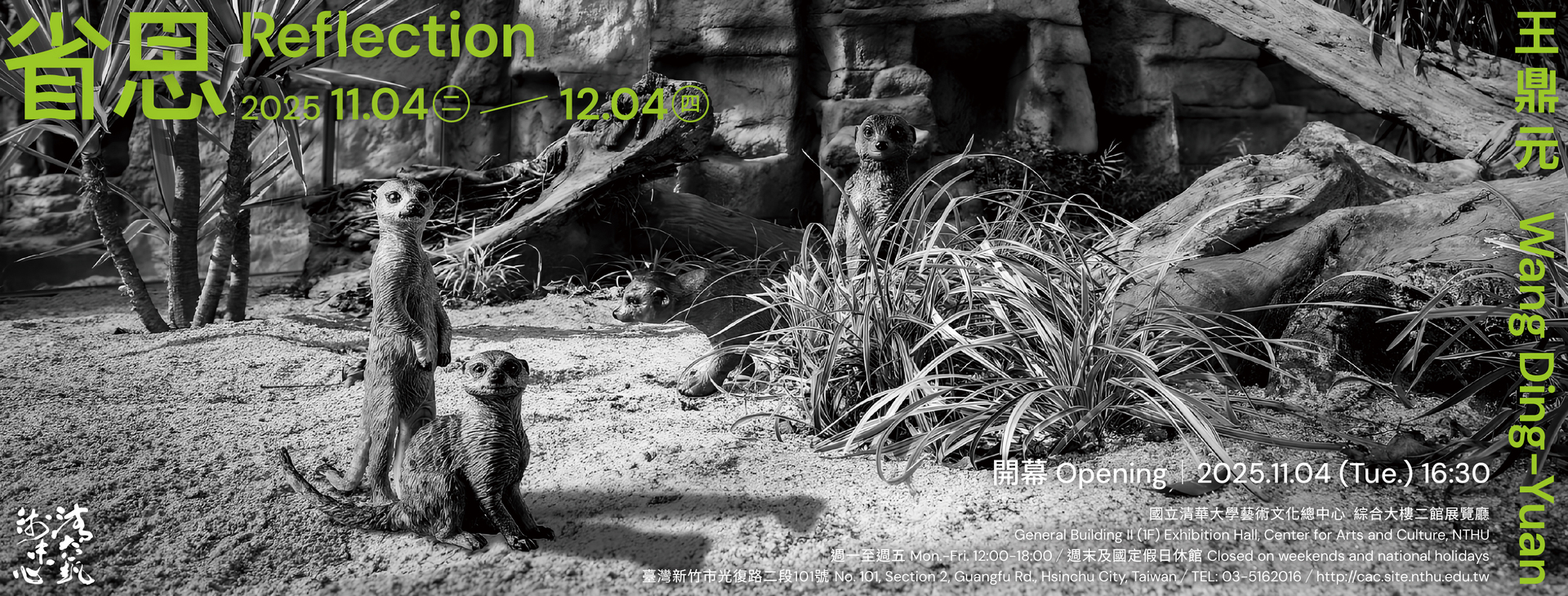【省思】王鼎元 / "Reflection" Wang Ding-Yuan

展覽開幕
2025 / 11 / 4(二)16:30 ;同展覽地點 → 地圖
展覽期間
2025 / 11 / 4(二)—— 12 / 4(四)週一至週五 12:00-18:00,週末及國定假日休館
展覽地點
國立清華大學 藝文總中心綜二館展廳
展覽介紹
《省思》王鼎元攝影個展以動物平權為核心,透過其影像與深刻編排,喚起觀者對自然永續與生命尊重的深層反思。此展匯聚藝術家王鼎元多年創作歷程精華,完整呈現《台灣愛丁堡動物園計劃》系列作品,以批判性與哲思交織的視角,回應當代社會對動物圈養與環境永續的議題。王鼎元以攝影為媒介,融合個人生命經驗與國際動物平權理念,構築出一場視覺與心靈的對話。
展覽靈感源自英國愛丁堡動物園「不圈養大象」的行動。該園以雕像取代真象,並公開說明無法提供大象所需的自然遷徙環境,因此選擇不再圈養。這種「負圈養」的理念深深觸動王鼎元,使他開始思索臺灣動物園的現況與人類對動物的態度。他走訪全臺動物園,拍攝園舍空間與光影,再以模型動物進行後製,創造出真假交錯的超現實影像,讓觀者在熟悉與陌生之間產生省思。
王鼎元的創作並非一蹴可幾。早期作品如《你眼中所見之處是我心中僅剩的藍》與《黑洞》系列,即展現他對圈養動物心理狀態的關注。他以冷色調與重複行為的捕捉,揭示動物在牢籠中所承受的孤寂與精神壓迫。這些作品不僅是視覺呈現,更是情感與倫理的訴求,直指人類對動物的無形暴力。
同時呼應秋季策展主題「自然永續 藝術迴響」,在全球氣候危機日益嚴峻的背景下,藝術成為反思與行動的媒介。王鼎元的作品不僅是對動物的凝視,更是對人類角色的質疑與提醒。他以藝術語言引導觀者重新思考自身在地球生態中的責任,並鼓勵在日常生活中實踐永續理念,觀者得以進入一場關於生命、記憶與環境的深層對話,形塑激發共鳴的場域,進而培養尊重自然、珍惜資源的價值觀,共同邁向永續未來。
展覽靈感源自英國愛丁堡動物園「不圈養大象」的行動。該園以雕像取代真象,並公開說明無法提供大象所需的自然遷徙環境,因此選擇不再圈養。這種「負圈養」的理念深深觸動王鼎元,使他開始思索臺灣動物園的現況與人類對動物的態度。他走訪全臺動物園,拍攝園舍空間與光影,再以模型動物進行後製,創造出真假交錯的超現實影像,讓觀者在熟悉與陌生之間產生省思。
王鼎元的創作並非一蹴可幾。早期作品如《你眼中所見之處是我心中僅剩的藍》與《黑洞》系列,即展現他對圈養動物心理狀態的關注。他以冷色調與重複行為的捕捉,揭示動物在牢籠中所承受的孤寂與精神壓迫。這些作品不僅是視覺呈現,更是情感與倫理的訴求,直指人類對動物的無形暴力。
同時呼應秋季策展主題「自然永續 藝術迴響」,在全球氣候危機日益嚴峻的背景下,藝術成為反思與行動的媒介。王鼎元的作品不僅是對動物的凝視,更是對人類角色的質疑與提醒。他以藝術語言引導觀者重新思考自身在地球生態中的責任,並鼓勵在日常生活中實踐永續理念,觀者得以進入一場關於生命、記憶與環境的深層對話,形塑激發共鳴的場域,進而培養尊重自然、珍惜資源的價值觀,共同邁向永續未來。
Opening
2025 / 11 / 4(Tue.)16:30 ;at the same venue → MAP
Exhibition Period
2025 / 11 / 4(Tue.)—— 12 / 4(Thu.)Mon-Fri 12:00-18:00, Closed on weekends & national holidays
Venue
General Building II (1F) Exhibition Hall, Center for Arts and Culture, NTHU
Exhibition Introduction
Reflection, a solo photography exhibition by Wang Ding-Yuan, centers on animal rights and equality. Through evocative imagery and thoughtful curation, it invites viewers to deeply reflect on sustainability and the respect for life. The exhibition showcases the essence of Wang’s years-long creative journey, presenting the complete series of The Taiwan Edinburgh Zoo Project. With a perspective that blends critique and philosophical inquiry, the works respond to contemporary issues surrounding animal captivity and environmental sustainability.
The inspiration for this exhibition stems from the Edinburgh Zoo’s decision not to keep elephants in captivity. Instead of housing real elephants, the zoo installed statues and publicly explained its inability to provide the natural migratory environment elephants require. This concept of “negative captivity” profoundly moved Wang Ding-Yuan, prompting him to examine the current state of Taiwanese zoos and humanity’s attitude toward animals. He visited zoos across Taiwan, photographing enclosures and the interplay of light and space. By digitally inserting model animals into these scenes, he created surreal images that blur the line between reality and illusion, encouraging viewers to reflect on the familiar and the unfamiliar.
Wang’s artistic evolution has been gradual and deliberate. Early works such as The Blue You See Is All That Remains in My Heart and the Black Hole series already revealed his concern for the psychological state of captive animals. Using cool tones and repetitive behaviors, he captured the loneliness and mental distress animals endure in confinement. These pieces are not merely visual presentations—they are emotional and ethical appeals that confront the invisible violence humans inflict on animals.
Echoing the autumn curatorial theme “Nature Sustainability, Artistic Resonance,” the exhibition positions art as a medium for reflection and action amid the intensifying global climate crisis. Wang’s work is not only a gaze upon animals but also a challenge and reminder of humanity’s role. Through the language of art, he guides viewers to reconsider their ecological responsibilities and encourages the practice of sustainability in everyday life. The exhibition becomes a space for deep dialogue about life, memory, and the environment—fostering empathy and cultivating values of respecting nature and cherishing resources, as we collectively move toward a sustainable future.
The inspiration for this exhibition stems from the Edinburgh Zoo’s decision not to keep elephants in captivity. Instead of housing real elephants, the zoo installed statues and publicly explained its inability to provide the natural migratory environment elephants require. This concept of “negative captivity” profoundly moved Wang Ding-Yuan, prompting him to examine the current state of Taiwanese zoos and humanity’s attitude toward animals. He visited zoos across Taiwan, photographing enclosures and the interplay of light and space. By digitally inserting model animals into these scenes, he created surreal images that blur the line between reality and illusion, encouraging viewers to reflect on the familiar and the unfamiliar.
Wang’s artistic evolution has been gradual and deliberate. Early works such as The Blue You See Is All That Remains in My Heart and the Black Hole series already revealed his concern for the psychological state of captive animals. Using cool tones and repetitive behaviors, he captured the loneliness and mental distress animals endure in confinement. These pieces are not merely visual presentations—they are emotional and ethical appeals that confront the invisible violence humans inflict on animals.
Echoing the autumn curatorial theme “Nature Sustainability, Artistic Resonance,” the exhibition positions art as a medium for reflection and action amid the intensifying global climate crisis. Wang’s work is not only a gaze upon animals but also a challenge and reminder of humanity’s role. Through the language of art, he guides viewers to reconsider their ecological responsibilities and encourages the practice of sustainability in everyday life. The exhibition becomes a space for deep dialogue about life, memory, and the environment—fostering empathy and cultivating values of respecting nature and cherishing resources, as we collectively move toward a sustainable future.